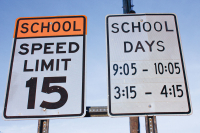Not so backcountry
When Al Smith arrived at the backcountry campsite in the Lake Fontana area of the Great Smoky Mountains National Park for a fall camping trip last month, he didn’t find the remote backcountry experience he’d been looking forward to.
Instead, he found large groups of campers with sprawling tent sites more reminiscent of car camping found at front-country campgrounds.
Campsites were strewn with pot racks, ice chests, deep fat fryers, lawn chairs, food prep tables, propane cylinders, gas-fired lanterns and battery-powered radios, Smith said. At night, campers played the radio, drank liquor and six packs while enjoying small bonfires, Smith said.
“If they want to car camp then let them go someplace other than the backcountry,” said Smith, an avid backpacker who lives in Maryville, Tenn. “Those of us who hike into the backcountry have a reasonable expectation of a backcountry-esque experience.”
Smith couldn’t simply move to another campsite. Camping in the backcountry is limited to designated campsites. Campers must register for a specific site before heading into the woods and must stick to the site they register for.
Smith said the culprit behind the lavish campsites was the use of horse-drawn carts and hand-pushed carts that allowed campers to haul in far more gear than the average backpacker. The carts are popular with some backcountry campers who want to bring along more of the comforts of home, according to Kent Orr, the manager of Fontana Village Boat Marina.
Orr rents hand carts to backcountry campers for $20 a trip, whether it’s for one night or a week. Orr will haul the campers, their carts and gear across Lake Fontana on a boat. The lake shuttle saves campers two days of hiking by depositing them closer to desired backcountry camping areas. Some campers bring their own handcarts, he said
“The carts are really handy,” Orr said. “I can carry in on one cart what four people can carry on their back.”
To Smith, that’s exactly the problem.
“Most backpackers I know would object to the environment that results from being able to easily transport excessive quantities of camping gear into the backcountry,” Smith said. “Backpackers have shared with me their outrage at the practice.”
The park has no policy limiting the volume and nature of the gear campers haul on the hand carts.
“There is no limit on how much stuff you can bring in the backcountry,” said Bob Miller, spokesperson for the park.
In most cases, however, gear is limited by the weight factor. Backpackers are known to cut the handles off toothbrushes to lighten weight of their packs in a “every little bit counts” mentality. An airline bottle of liquor and an I pod would be considered a luxury, while radios and six-packs are likely out of the question for backpackers, largely ensuring a wilderness experience for others at the shared campsites. The use of handcarts breaks that mold, however.
Park policy
Smith said he does not fault the campers who use the carts.
“Don’t get me wrong,” Smith said. “I hold nothing against the participants in the group sites I witnessed on this trip. My bone to pick is with the National Park Service for condoning it.”
According to park policy, horse-drawn carts are illegal, and hand-pushed carts are limited to only a handful of campsites. (see “Park Cart Policy” box). Miller said the park incorporated the limited use of handcarts into park policy largely because it was a pre-existing use.
The trails where handcarts are allowed are the remnants of old roadbeds, “as opposed to traditional trails that were built as trails,” Miller said.
It appears backcountry campers are not following the park’s policy, however.
Campers are taking hand-pushed carts beyond the cut-off point for the carts. In addition, some campers use horse-drawn carts. In those cases, horses are brought into the park along the Lake Shore trail. Their gear and carts are brought across the lake using services from Orr or other marinas. The carts are hitched to the horses, which then haul the gear the rest of the way.
Visitor education
The park does not go out of its way to publicize the cart policy. For example, cart policy — namely which campsites carts are allowed at — could be posted at kiosks where backpackers fill out reservation forms for their backcountry sites. Rangers could share cart policy with backpackers who call on the phone or reserve their sites in person.
But that would serve to advertise a practice the park isn’t exactly wild about and would rather keep to a minimum.
Since those using hand- and horse-drawn carts get their carts and gear across the lake using Orr’s services, informing Orr of the park’s policy would be a good place for the park to start, however. Orr was not aware that horse-drawn carts are illegal.
“They are real lenient on that,” Orr said of horse-drawn carts. Orr also was not aware that hand carts are limited to specific campsites. When asked where campers could take the carts, Orr said people could take them anywhere they wanted.
“They go way up,” Orr said. “I just took 12 people over and they had five carts and they are going on about an 8-mile hike.”
Hand carts are not allowed eight miles into the park, however, but are limited to the first five miles of trail at Hazel Creek.
Park cart policy
Horse-drawn carts to transport camping gear is not permitted anywhere in the Great Smoky Mountains National Park. The use of hand-pushed carts is limited to a handful of campsites and less than a dozen miles of trail, all in the Lake Fontana area.
Handcarts are allowed on:
• The first 5 miles of the Hazel Creek Trail from the lake shore to
campsites 86, 85, 84 and 83.
• The first couple hundred yards of the Forney Creek Trail from
the lake shore to campsite 74.
• The first five miles of the Noland Creek Trail from the trail head
off Lake View Drive to campsites 65 and 64.
• Handcarts are not allowed on the Lake Shore Trail or any
other trails.





